For millennia, people have been captivated by the world of crystals and gemstones. Crystals are famous for both spiritual and utilitarian reasons because, beyond their visual appeal, they possess mystical and therapeutic qualities. People like yellow crystals for optimism, happiness, and illumination. Black crystals and Red Crystals, often associated with protection and grounding, also hold significant value in metaphysical practices. We will explore the features, meanings, and advantages of yellow crystals in this extensive book, uncovering their mysteries and considering the possible effects they may have on our lives.
Given that many gemstones can have yellow hues, the phrase “yellow crystal gemstone” is very ambiguous. Some yellow gemstone samples are as follows:
Table of Contents
Types of Yellow Crystals
1. Citrine
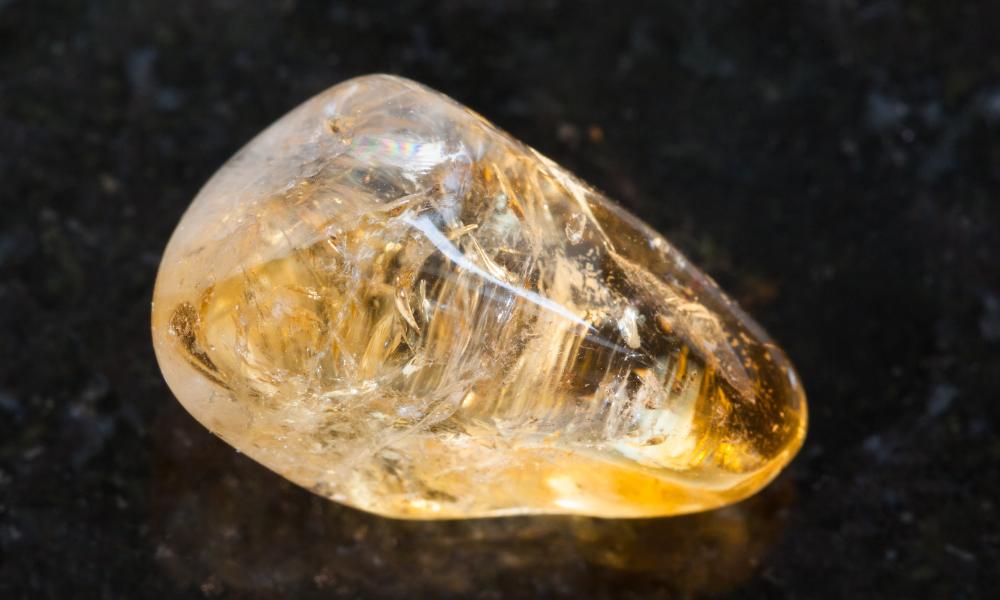
Citrine is the stunning yellow to brownish-orange quartz variant. It’s a type of yellow crystal. This translucent to transparent gemstone is frequently utilized in jewelry. The following are some noteworthy characteristics and information about citrine:
Color
The hues of citrine range from pale yellow to luscious golden brown. The most valuable and sought-after citrine is frequently a vivid, rich shade of yellow or golden.
Formation
Citrine forms when you heat amethyst, another type of quartz. Since natural citrine is uncommon, most citrine gemstones available today are heat-treated amethyst that has been given a yellow hue.
Hardness
Citrine is a somewhat durable stone that you can wear every day. This yellow crystal has a Mohs hardness of 7.
Sources
Citrine is all over the world in a variety of places. There are sizable deposits in the US, Bolivia, Madagascar, Brazil, Spain, and Bolivia.
Metaphysical Properties
In crystal healing and metaphysical traditions, citrine is linked to success, abundance, and good vibes. It fosters confidence, inventiveness, and clarity.
Jewelry
Jewelry made of citrine is often used as bracelets, necklaces, earrings, and rings. It looks good in professional and informal settings thanks to its warm, cheery tone.
Care
Despite its relative durability, handle citrine cautiously to avoid scratches and damage. Avoid subjecting citrine jewelry to strong chemicals or excessive heat, and clean it with a bar of light soap and water.
2. Yellow Sapphire
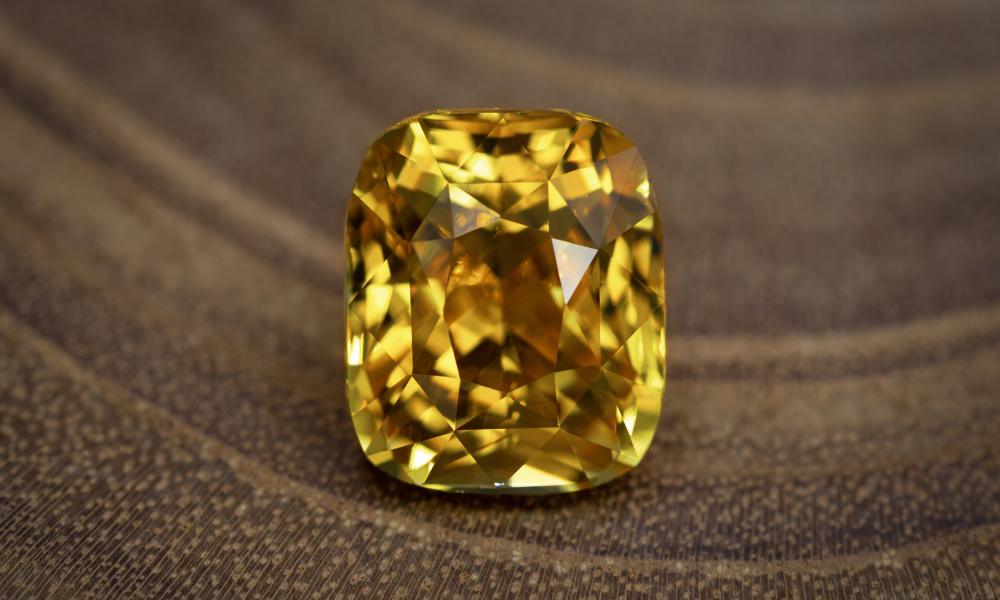
Yellow sapphire is another form of yellow crystal, referred to as “Pukhraj” in Hindi, and is a valuable gemstone that is a kind of corundum. Here are some noteworthy characteristics and information about yellow sapphire:
Color
The hue of a yellow sapphire is the main factor influencing its quality. The color of yellow sapphires can vary from a light yellow to a rich, vibrant golden tint. The most sought-after stones are usually transparent and have a medium to strong yellow color.
Hardness
With a Mohs hardness of 9, yellow sapphires are hard gemstones similar to other sapphires. Because of this, it is strong and appropriate for daily use.
Clarity
Yellow sapphires of superior quality often have few imperfections and are transparent. On the other hand, certain stones could have apparent imperfections, sometimes called “silk,” which can give them the distinctive look of a “star sapphire.”
Cut
Yellow sapphires are frequently shaped into cushion, emerald, oval, and round cuts. The cut impacts the gem’s overall brightness and beauty.
Origin
Sapphires are all over the world in different places. Several prominent origins of yellow sapphires are in Australia, Madagascar, Sri Lanka, and Thailand.
Astrological and Cultural Significance
In Vedic astrology, yellow sapphire links to the planet Jupiter bestows wealth, success, and good fortune upon the wearer. People wear it as a symbol of knowledge and wisdom in several civilizations.
Jewelry
A popular option for many kinds of jewelry, including necklaces, rings, earrings, and bracelets, is yellow sapphire. It is frequently incorporated into both classic and modern designs.
Care
Cleaning yellow sapphires using a gentle soap and water solution regularly is essential to preserve their luster. Steer clear of harsh chemicals and extremely high or low temperatures to save these yellow crystals.
3. Topaz

Although topaz is a multicolored gemstone, blue tones are the ones that are most frequently associated with it. But topaz is also available in shades of pink, brown, purple, green, orange, and yellow. The following are some noteworthy characteristics and information about the yellow crystal, topaz:
Color
Although most people associate topaz with its blue hue, yellow topaz is also a well-liked and eye-catching type. Pale yellow to golden brown are possible hues for yellow topaz.
Hardness
Topaz has an 8 on the Mohs hardness scale, making it a rather hard gemstone. Thus, it can be applied in numerous jewelry designs.
Treatment
Although natural yellow topaz is somewhat common, some stones may be treated to improve their hue, such as by heating. Another popular treatment for topaz is radiation, particularly for the production of blue hues.
Sources
Topaz is all around the world. The United States, Brazil, Russia, Sri Lanka, and Mexico are a few noteworthy sources.
Imperial Topaz
This topaz type is extremely rare and valuable because of its vivid reddish-orange to pinkish-orange tint. High-grade stones are “Imperial Topaz”.
Astrological and Metaphysical Properties
Varied cultures have varied associations with topaz in terms of metaphysical characteristics. It is a lucky, protective, and creative stone. According to astrology, yellow topaz corresponds with the sign of Sagittarius.
Jewelry
Jewelry such as bracelets, necklaces, earrings, and rings frequently uses yellow topaz. It is a warm, cheery color that performs well in conventional and contemporary environments.
Care
Topaz needs maintenance to keep its brightness. Keep it away from strong chemicals and very cold or very hot temperatures, and wash it with a gentle soap and water.
4. Amber

Amber is a rare and intriguing yellow crystal that is actually petrified tree resin rather than a mineral. For millennia, it has been utilized in decorative items and jewelry. The following are some noteworthy characteristics and information about amber:
Color
Amber can come in tones of orange, red, green, and even blue, although its most prevalent color association is warm golden to brownish-yellow. Often, inclusions and contaminants give the color.
Transparency
Unlike some gemstones, amber is usually translucent, allowing light to pass through but not completely transparent. To further enhance its distinctiveness, it might have tiny inclusions, air bubbles, or even old plant or insect material.
Formation
Resin from old trees, mostly conifers, is used to make amber. This resin eventually fossilizes and solidifies to become the amber that we know today.
Locations
There are substantial amber deposits throughout the world, including the Dominican Republic, Mexico, Myanmar, the Baltic region (home of Baltic amber), and other places.
Inclusions
The inclusions in amber are well-known and may comprise air bubbles, plant matter, or even imprisoned insects. Each piece of amber can be uniquely crafted by inclusions that narrate the history of the ancient surroundings.
Age
Amber which is a type of yellow crystal is famous for its age. Some specimens date back tens of millions of years. When insects or other animals preserved in amber are found, it can reveal important information about extinct ecosystems.
Jewelry
People use amber to make jewelry, either as carved beads or as polished cabochons. Its use as amulets, pendants, earrings, and other decorative items in many cultures is common.
Metaphysical Properties
Some people think that amber has a relaxing and grounding effect and links to healing abilities. It’s also encourages good vibes.
Care
In comparison with other gemstones, amber is rather delicate, so handle it cautiously to avoid scratches. Clean amber carefully with a soft cloth and a light soap, avoiding contact with strong chemicals and extreme heat.
5. Yellow Jasper
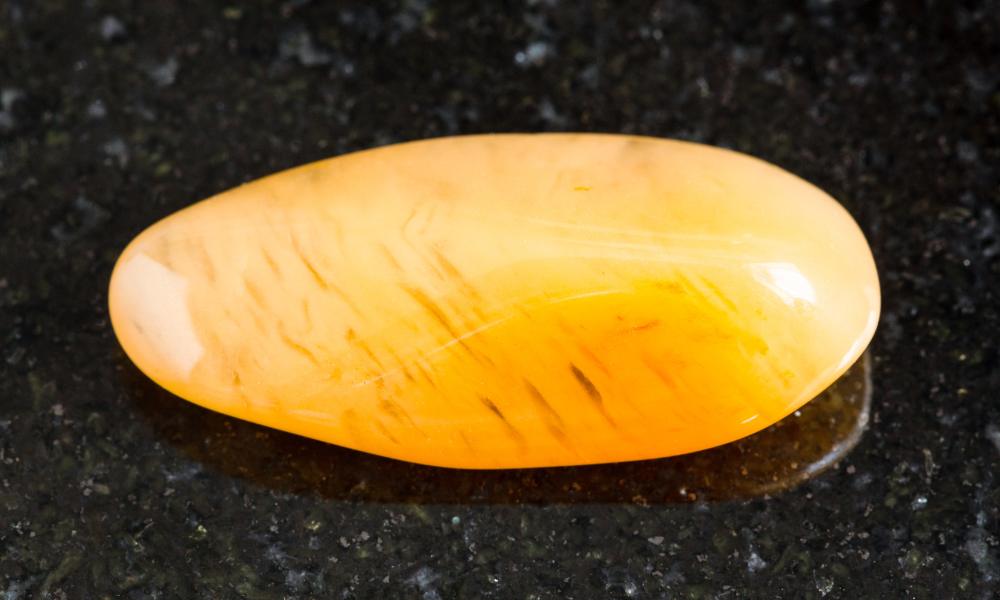
Yellow jasper is a kind of quartz that is a member of the chalcedony family. Its bright, mustard-yellow to golden-yellow hue is famous. The following are some noteworthy characteristics and information about this yellow crystal, which is yellow jasper:
Color
Yellow jasper, as its name implies, comes in a variety of yellow tones, from light yellow to rich golden. The hue could be consistent or show intriguing bands and patterns.
Composition
The primary component of jasper is silicon dioxide (SiO2), which is also the mineral that constitutes quartz. Minerals and impurities are frequently the source of the color in jasper.
Hardness
With a Mohs hardness of roughly 6.5 to 7, yellow jasper is a reasonably durable stone for jewelry and lapidary objects.
Patterns
There are interesting banding and patterns in jasper, especially yellow jasper. The patterns inside the stone could be erratic or take the form of complex designs.
Sources
Jasper is all over the world in a variety of places. Specifically, yellow jasper might originate from the US, Madagascar, Brazil, India, and Russia.
Metaphysical Properties
Metaphysical ideas typically attribute stabilizing and caring qualities to Jasper. In particular, yellow jasper boosts optimism, self-worth, and confidence.
Jewelry and Ornamental Use
People make a wide range of jewelry items, including pendants, cabochons, and beads, from yellow jasper. It is a well-liked option for both simple and complex designs because of its warm tone and distinctive patterns.
Care
Although jasper is a hard stone, however, clean it with a gentle cloth and a moderate soap. To keep the beauty of this yellow crystal, keep it away from strong chemicals and severe temperatures.
6. Yellow Apatite
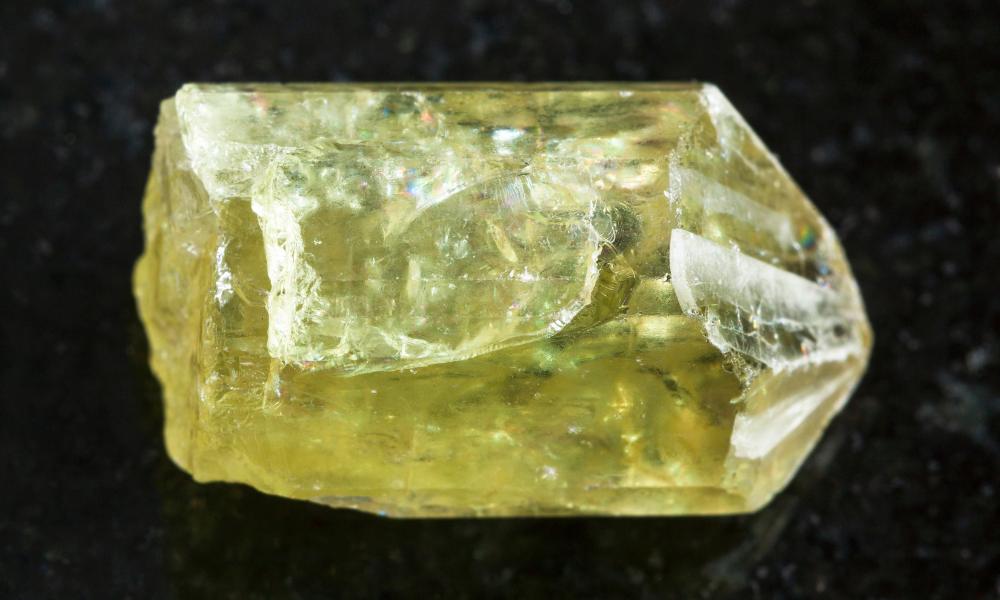
Apatite is a mineral group that includes yellow apatite as a gemstone variant. Phosphate minerals come in a variety of colors, including apatite. As its name implies, yellow apatite is distinguishable by its yellow coloring. The following are some salient features and details concerning this yellow crystal, which is yellow apatite:
Color
The tones of yellow in yellow apatite range from pastel, light yellows to more intense, saturated yellows. The hue of yellow can differ in strength.
Hardness
On the Mohs scale, apatite has a comparatively modest hardness of 5. People make jewelry from it, however, handle it cautiously to prevent scuffs and damage.
Transparency
Usually clear to translucent, yellow apatite lets light flow through the stone. When done properly, this can improve the piece’s aesthetic appeal.
Sources
Apatite is all over the world. However Yellow apatite is in notable places including Madagascar, Brazil, Mexico, and Myanmar.
Metaphysical Properties
In metaphysical ideas, apatite links to attributes like creativity, clarity, and communication. In particular, yellow apatite connects to manifestation and personal strength.
Jewelry
People make jewelry from yellow apatite such as pendants, earrings, and rings. People use it alone or in conjunction with other gemstones in a variety of contexts.
Care
Yellow apatite is moderately hard, so handle it cautiously to avoid scratches. Clean it with a gentle cloth and a small amount of soap. Avoid extreme temperatures and harsh chemicals to keep this yellow crystal safe.
Luster
When polished, yellow apatite can take on a vitreous (glass-like) shine that adds to its beauty.
Yellow Crystal Meaning
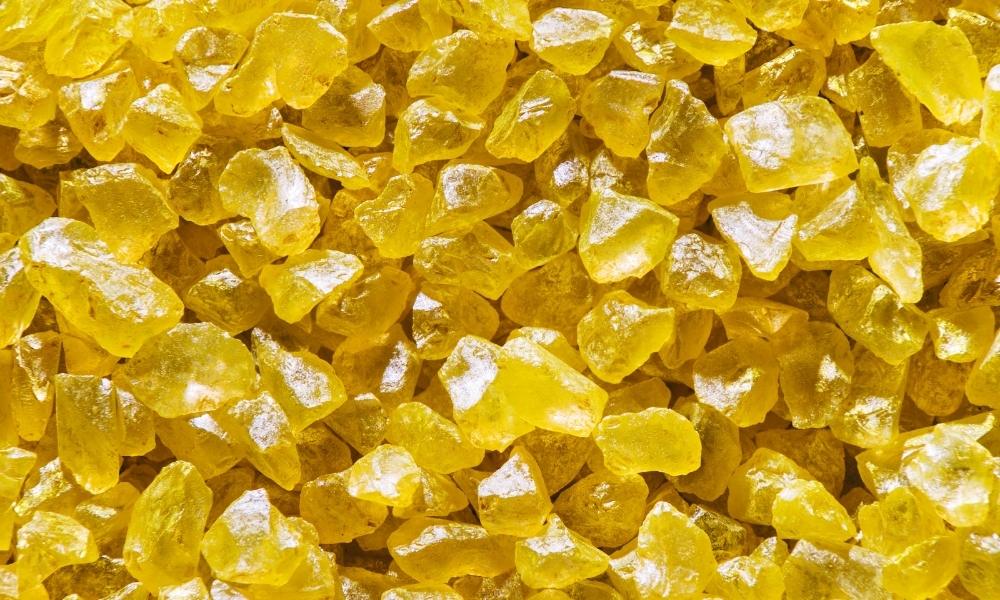
While each yellow gemstone may carry its own distinct significance, the lively shade has links with feelings of joy, vitality, and comfort, largely due to its resemblance to the sun, a vital source of life. Rock crystal clear quartz and yellow gemstones can additionally represent attributes like authority, assurance, and resilience. They have also ties to the solar plexus chakra, symbolizing fresh starts, intellect, youthfulness, and connectivity. This chakra is to oversee self-assurance, hence the association of yellow with enhancing confidence.
Yellow Crystals: A Visual Symphony
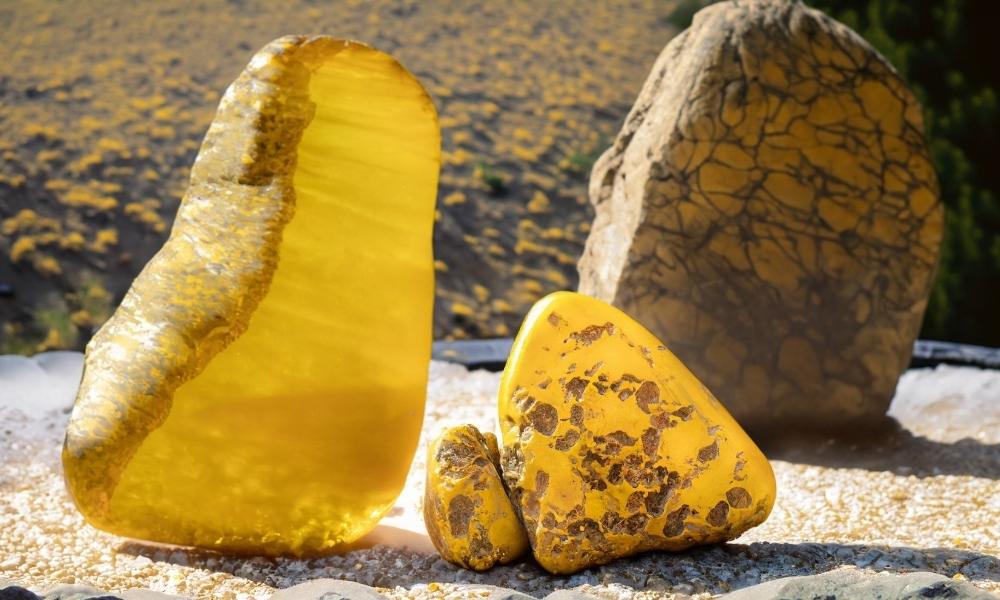
While golden stones may represent anything, to me, they symbolize despite the bone-chilling temperatures, the sunny radiant of the yellow color can stir the senses, arousing feelings of cheerfulness and positive energy. Vibrating in resonance with the sun`s hue, spaces come alive, filling the room with the lightness and cheerfulness of the sun’s energy. It is natural that citrine, with its pale yellow translucency or deep amber, will offer different metaphysical aspects compared to the rich darkness of zheltaya and epidote crystals.
The Spiritual Significance of Yellow
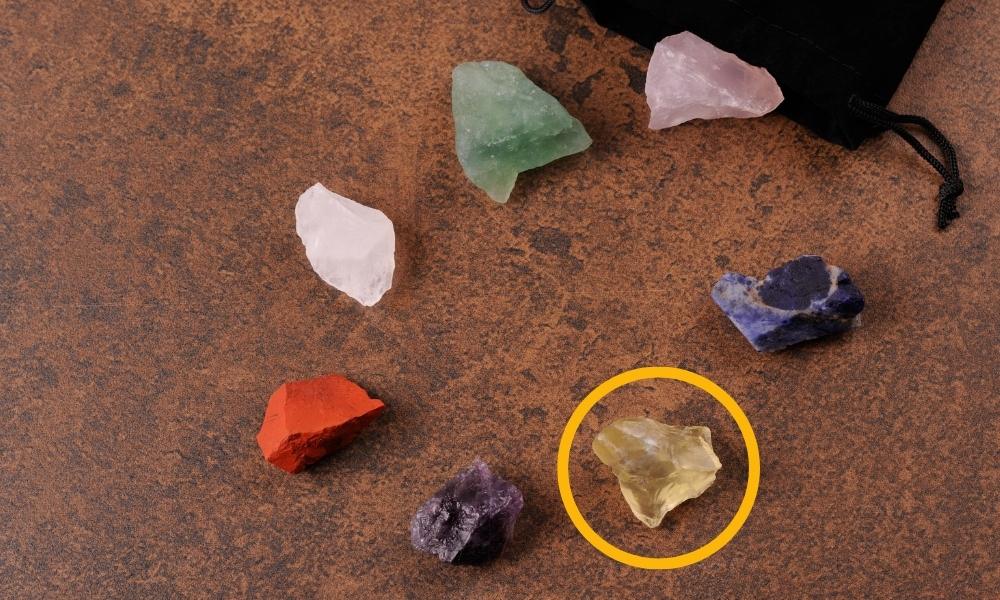
Spiritually, in numerous traditions, yellow represents enlightenment and wisdom, it stands for spiritual realization. The hue symbolizes this chakra that is the source of personal power and is located in the upper abdomen beside the other center which handles other aspects the ones such as self-confidence and transformation. When the yellow crystals or lemurian crystals are placed under this chakra, inner strength, and self-esteem are fortified, creating a deep-rooted sense of purpose and good self-awareness. They are specially applied in the field of meditation to promote concentration, clarity, and a spiritual level of understanding in the meditative persons.
Embracing Joy and Optimism
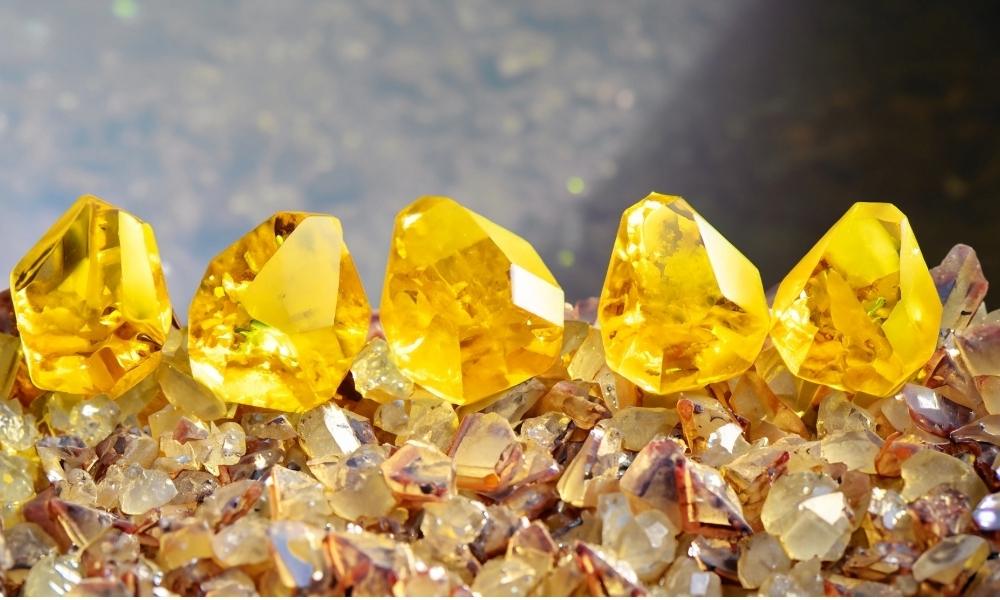
Yellow crystals are the personifications of vivid emotions, sparkling with a bright face and sunny disposition, guiding the souls to happiness. This high positive energy is sometimes enough to turn frowns upside down and eradicate sensations of depression, non-motivation, and negativity, providing a positive atmosphere on its own. May worn as an ornament, kept as a charm in the living space, or used as a ritual of healing to remind us to live with enthusiasm and gratitude.
Healing Properties of Yellow Crystals

The yellow stones are adored for their reputation for strengthening physical, spiritual, and emotional well-being in the practice of crystal healing. Citrine, which is also known as “the Merchant’s Stone” possesses the famous property of attracting all kinds of possessions because it radiates positive vibes to the world, thereby repelling adversities and negative energies. Modern society is stressful with constant distractions and changes, and people are looking for ways to get centered and relieve pressure. In these situations, Yellow Jasper is believed to restore stamina, vitality, and overall health. Other than the above mentioned, the yellow crystals are also associated with the digestive system and, therefore can be used as one’s strategic allies in the promotion of digestion, metabolism, and overall gut health.
Manifesting Creativity and Success

Yellow crystals have supernatural powers for decorating the creation, prosperity, and success in a person’s journey towards the future in life. They blaze the trails and their fiery passion encourages dreamers to spread their wings scorching the skies with stunning innovation and awe-inspiring inspiration. To use the yellow gem as an instrument that helps to surpass the obstacles, raise the spirits of that internal motivation, and find the hidden potential is never a bad idea either for a creative job or for a project. Besides, the stones have a symbolic meaning for the manifestation of abundance and growth of prosperity. Those stones, eventually, result in great satisfaction and accomplishment in one’s own life.
Yellow Crystal Benefits
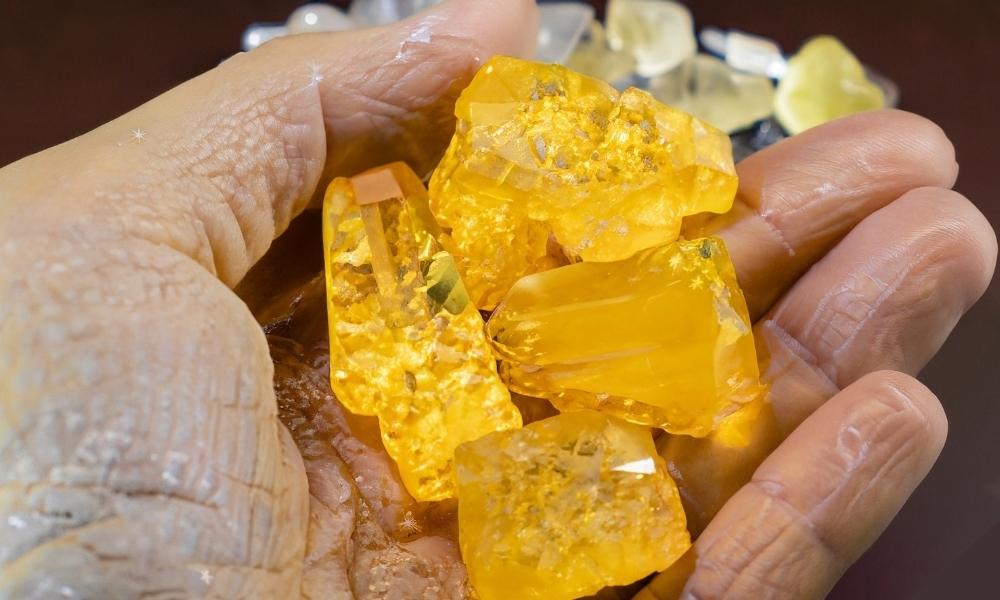
Since yellow crystals are typically linked to vigor, many people think that this stone can help those who are experiencing low energy. Its cheerful, bright color is also said to encourage mental clarity and can bring calmness when faced with difficulties or stressful situations.
Additionally, yellow is often thought to be a happy color, therefore some people think it can aid with depression. Some believe that yellow gemstones might aid in the fight against blood pressure, digestive problems, and even difficulties with reproduction. Nevertheless, there is no scientific evidence that gemstones of any kind will cure or prevent any form of illness, so if you have a problem of any kind, get medical attention.
Energizing and Uplifting Properties
Yellow crystals filled with sun intention direct the mind to the best state of feeling and empower it. Their bright color jolts you with happiness and joy, burning forever. This makes all the spaces unique, positive beings. In one way or another, these relevant gemstones become a fixture in our closets on daily basis and are usually displayed in various places as a constant reminder for us to be in our present moment and be grateful and happy. Their stimulating nature is known to cast away the fog of weariness and tiredness, while the spirits and calmness return to one’s body and mind.
Stimulating Creativity and Innovation
Vivid orange entities have a unique talent for energizing your mind and propelling you into new directions. A sudden dash of energy and creativity radiates from them lighting up the room and eventually, this releases the flow of inspirations and ideas. Whether you’re a visual artist, a writer, or an entrepreneur that weaves innovative pathways, working with yellow crystals in your creative space has proven to be a powerful source of breaking through creative blockades, improving problem-solving skills, as well as tapping into your artistic realm. These crystals sync with the state of being open to new ideas and new chances, and this is a formula for great accomplishments.
Promoting Mental Clarity and Focus
In the overwhelming world of today, being able to have focused mental clarity without any distraction is the best way to manage your daily tasks easily. Yellow and transparent crystals having a brightening effect on the mind will increase the power of the mind and bring clarity to the cognition. Yellow medium or crystals may be used in meditation or as decoration at the work-desk to sharpen mental focus and concentration, besides assisting in the personal decision-making process. Through the calm of silence as all distractions and uncertainties are clearing, this stone becomes our guide and helps us be the focused and productive we aim to be.
Nurturing Self-Confidence and Personal Power
Yellow crystals reverberate the yellow solar plexus chakra power, which is the energy center for one to be confident, magnanimous and have independence. Through their power to stimulate the solar plexus, yellow crystals boost self-confidence, implant a sense of inner strength and core of being, and grow a self-image that is pleasant. Whether it is in the realm of personal relationships, career development or even self-growth, yellow crystal can make you be confident in who you are and cultivate your self-worth.
Supporting Physical Health and Vitality
Besides that, these saturated entities have both emotional and spiritual benefits and physical healing powers. The Citrine that is quite often referred to as the top yellow stone is appreciated for its guts job in supporting the digestive system, the metabolism and, in general, for maintaining health. The yellowness of Jasper relates to its connection with the earth; thus, it is predominantly connected to grounding, strength, endurance, and resilience. The application of yellows crystals in the wellness routine may aid in balancing the energy system, solving physical pains, and calming the person psychologically, which may in turn lead to better wellness.
(FAQs) about Yellow Crystal
Q1. What is the yellow crystal called?
Citrine is another name for any yellow or orange-colored quartz crystal or cluster. Citrine is rather uncommon in nature, despite the fact that people often cut it as a gemstone.
Q2. What are yellow crystals good for?
Yellow crystals improve mental dexterity and intellectual stimulation. They can facilitate improved decision-making, reduce brain clutter, and increase focus. Creativity and Innovation: The vivid energy of yellow crystals fosters both of these qualities.
Q3. Which stone is the yellow stone?
The modern birthstone for November, citrine, is by far the most popular yellow gemstone. Because quartz is so abundant in the Earth’s crust, this form of quartz is affordable and ranges in color from yellow to orange or brown.
Q4. What is the yellow crystal for love?
The hues of the crystals vary from yellow to yellow-green, with some even exhibiting brown undertones. A potent stone for healing and regeneration is garnet. If you want to experience the potent healing energy of love, try the Natural Garnet Healing Bracelet.
Q5. Is yellow stone lucky?
The Citrine stone, the epitome of all sunny, bright yellow crystals, is famous for its wonderful mood-boosting abilities as well as its good fortune and positive energy. Citrine not only purges negative energy from you but also positions you to attract all you want.
Stay Tuned to Gems Tycoon for all gems-related articles.










